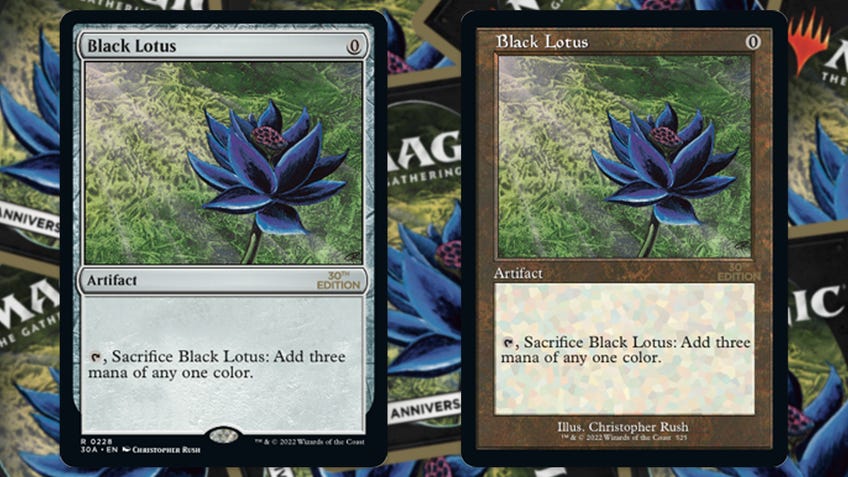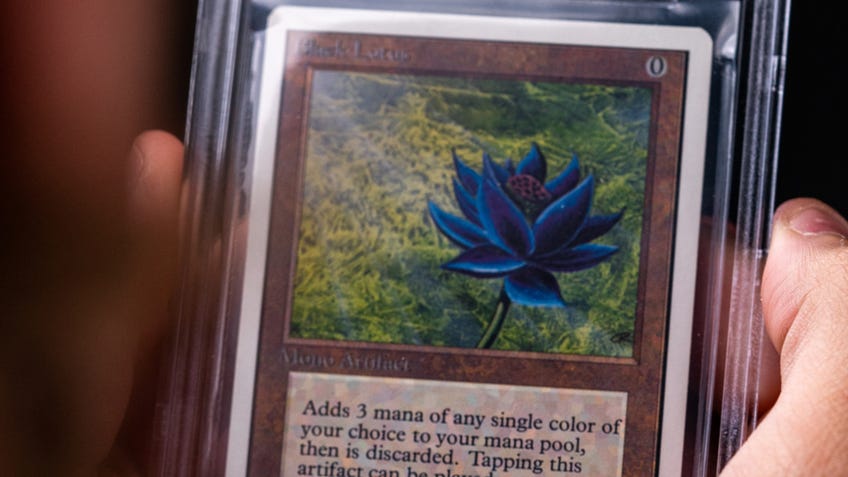The History of Black Lotus: Magic: The Gathering's legendary Holy Grail card
From forbidden artifact to half-a-million-dollar icon.
In Magic: The Gathering’s 30-year history, spanning across tens of thousands of cards and a myriad of playing systems, no cards have had more influence on the game as the Power Nine - a set of nine extremely powerful cards from the card game’s earliest Alpha, Beta and Unlimited sets.
Among those nine, one stands above them all: Black Lotus. There isn’t a card within the whole of the MTG pantheon that has quite captured the imagination as this innocuous bit of horticulture. But what is Black Lotus? Why was it banned alongside the other Power Nine? And how did one Black Lotus end up being sold for over half a million dollars?
Before we dive into why Black Lotus has earned its place as the pinnacle of the Power Nine, we need to understand a little bit about mana and card economy. You know, the fun stuff!

In Magic: The Gathering, the primary resource used for pretty much anything you do in-game is mana. On the top right of any MTG card, there will be an indication of which colour and quantity of corresponding mana are needed to play that card. So, for example, if you wanted to play Peek you need to have one Blue land available in your mana pool to use its effect. Your mana pool is the sum of all lands played throughout a game and is slowly built upon over the course of a game - as you are only allowed to play one land card per turn.
In monetary value and status, no other Magic: The Gathering card has quite reached the apex Black Lotus has.
Black Lotus is a mono artifact (meaning it can only be played once) with no casting cost (so no mana is required) that allows a player to add three mana of any single colour to their mana pool. Not just to their hand, which would be powerful enough, but directly into the field of play. This essentially gives them a three-turn head start against their opponent.
As the number of cards you can use during a turn is only limited by the amount of mana you have in your pool (compared to the summoning limits of a game like Yu-Gi-Oh!), Black Lotus could allow a player, especially one playing an aggressive Red mana deck, the opportunity to destroy their opponent with zero ability to be countered.
Not long after the initial release of Black Lotus in 1993, it was swiftly restricted and subsequently banned from all but MTG’s Vintage format, making one solitary appearance in the 1994 MTG Championships before never being seen again. The same applies to the rest of the Power Nine, whose powers ranged from similar mana fetches like Lotus’ to my personal favourite, Time Walk, which just straight up lets you have a second turn. The Power Nine were ridiculous and gloriously unbalanced and had to be banned. Soon, their notoriety had made the rare MTG cards worth a fortune.
In monetary value and status, no other Magic: The Gathering card has quite reached the apex Black Lotus has. But it wasn’t always this way.
Black Lotus and the rest of the Power Nine were only printed for the early Alpha, Beta and Unlimited sets right at the very beginning of Magic: The Gathering’s inception. All in all, it is estimated that only about 1,100 Black Lotus cards were ever printed. This, however, didn’t immediately lead to the eye-watering prices we see today. The earliest recorded resale price of a Black Lotus is in issue 1 of Scrye Magazine from June 1994, which lists a Beta set Lotus at a mere $22.50 (roughly $45 in today’s money).

As the years rolled on, this price started to increase. 10 years later, in 2004, you could expect the same Beta Lotus to be worth around $1,000 ($1,567 today). That equates to a percentage value increase of over 3,000% - which is absolutely huge, but $1,000 is not a completely bombastic number. However, over the next 15 years something magical and a little bit odd happened: YouTube.
The value of Black Lotus doesn’t lie in what it is, but in what it represents.
As the video-sharing platform ballooned in popularity heading into the 2010s and beyond, so did the desire to watch Nyan cats, chocolate rain and people opening packets of trading cards. Soon, YouTube channels started making the allure of pulling that fateful flower all the more tantalising. One such video from openboosters featuring a Black Lotus pull has amassed over seven million views. Couple that with a generation of players who had gotten older, nostalgic and gained access to disposable income, and very soon the act of owning Black Lotus became a status symbol in and of itself.
Going by MTGPrice, the cost of that Beta Black Lotus in 2014 was now worth $3,376 - a jump of 237% between then and ‘04. But in just five years, the price hiked to an eye-watering $21,000 dollars by 2019, a 552% increase in half the time. The apex for a Beta Black Lotus came on June 3rd 2021, when one sold at auction for $48,000. That doesn’t even come close to the jaw-dropping $511,100 a mint-condition Alpha Lotus signed by the card’s artist Christopher Rush sold for in 2019, which made Black Lotus one of the most valuable trading cards ever sold.

It’s difficult to fully articulate why Black Lotus is so important to the history of this great game. Black Lotus artistically, compared to modern Magic: The Gathering cards, is rather archaic. Though evocative of a certain age of illustration, the last 30 years have seen massive innovation across both art style and in-game playability. Ultimately, when push comes to shove, Black Lotus is merely a piece of paper that you now can’t even use for the function it was created for.
Yet the value of Black Lotus doesn’t lie in what it is, but in what it represents. For players who 30 years ago first dived into the magnificence of Magic: The Gathering, it is a reminder of just how broken the mechanics of the original game were, or how wonderfully charming the art used to be. For some, Black Lotus is an investment, understanding the value of an item goes well beyond what an item is made of.
In the end, though, a video from an MTG Draft event in Chiba, Japan in 2018 quantifies everything about what makes Black Lotus so special. Pulling one out from a pack sends a crowd into euphoric joy. For something as simple as a card to do this, is true magic.









